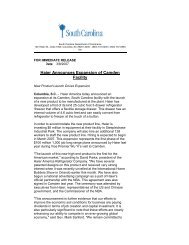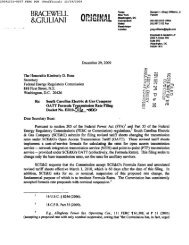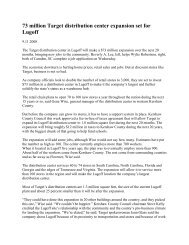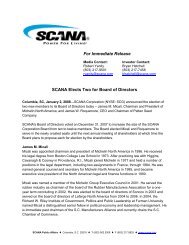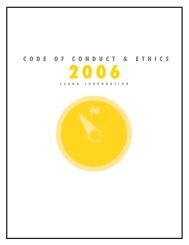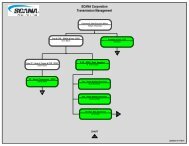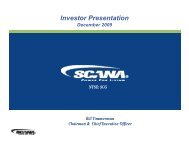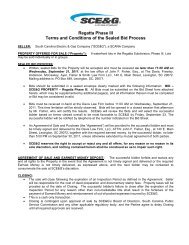10-K - SCANA Corporation
10-K - SCANA Corporation
10-K - SCANA Corporation
Create successful ePaper yourself
Turn your PDF publications into a flip-book with our unique Google optimized e-Paper software.
Table of Contents<br />
The RSA allows natural gas distribution companies to request annual adjustments to rates to reflect changes in revenues and<br />
expenses and changes in investment. Such annual adjustments are subject to certain qualifying criteria and review by the SCPSC.<br />
Effective February 12, 20<strong>10</strong>, the PHMSA issued a final rule establishing integrity management requirements for gas<br />
distribution pipeline systems. SCE&G has developed a plan and procedures to ensure that it will be fully compliant with this rule.<br />
SCE&G believes that any additional costs incurred to comply with the rule will be recoverable through rates.<br />
CRITICAL ACCOUNTING POLICIES AND ESTIMATES<br />
Following are descriptions of Consolidated SCE&G’s accounting policies and estimates which are most critical in terms of<br />
reporting financial condition or results of operations.<br />
Utility Regulation<br />
Consolidated SCE&G’s regulated operations record certain assets and liabilities that defer the recognition of expenses and<br />
revenues to future periods in accordance with accounting guidance for rate-regulated utilities. In the future, in the event of<br />
deregulation or other changes in the regulatory environment, Consolidated SCE&G may no longer meet the criteria of accounting for<br />
rate-regulated utilities, and could be required to write off its regulatory assets and liabilities. Such an event could have a material<br />
effect on the results of operations, liquidity or financial position of Consolidated SCE&G’s Electric Distribution and Gas Distribution<br />
segments in the period the write-off would be recorded. See Note 2 to the consolidated financial statements for a description of<br />
Consolidated SCE&G’s regulatory assets and liabilities, including those associated with Consolidated SCE&G’s environmental<br />
assessment program.<br />
Consolidated SCE&G’s generation assets would be exposed to considerable financial risks in a deregulated electric market. If<br />
market prices for electric generation do not produce adequate revenue streams and the enabling legislation or regulatory actions do not<br />
provide for recovery of the resulting stranded costs, Consolidated SCE&G could be required to write down its investment in those<br />
assets. Consolidated SCE&G cannot predict whether any write-downs would be necessary and, if they were, the extent to which they<br />
would affect Consolidated SCE&G’s results of operations in the period in which they would be recorded. As of December 31, 2011,<br />
Consolidated SCE&G’s net investments in fossil/hydro and nuclear generation assets were $3.1 billion and $1.8 billion, respectively.<br />
Revenue Recognition and Unbilled Revenues<br />
Revenues related to the sale of energy are recorded when service is rendered or when energy is delivered to customers.<br />
Because customers are billed on cycles which vary based on the timing of the actual reading of their electric and gas meters, SCE&G<br />
records estimates for unbilled revenues at the end of each reporting period. Such unbilled revenue amounts reflect estimates of the<br />
amount of energy delivered to customers for which they have not yet been billed. Such unbilled revenues reflect consideration of<br />
estimated usage by customer class, the effects of different rate schedules, changes in weather and, where applicable, the impact of<br />
weather normalization provisions of rate structures. The accrual of unbilled revenues in this manner properly matches revenues and<br />
related costs. As of December 31, 2011 and 20<strong>10</strong>, accounts receivable included unbilled revenues of $117.8 million and<br />
$123.4 million, respectively, compared to total revenues of $2.8 billion for each of such years.<br />
Nuclear Decommissioning<br />
Accounting for decommissioning costs for nuclear power plants involves significant estimates related to costs to be incurred<br />
many years in the future. Among the factors that could change SCE&G’s accounting estimates related to decommissioning costs are<br />
changes in technology, changes in regulatory and environmental remediation requirements, and changes in financial assumptions such<br />
as discount rates and timing of cash flows. Changes in any of these estimates could significantly impact SCE&G’s financial position<br />
and cash flows (although changes in such estimates should be earnings-neutral, because these costs are expected to be collected from<br />
ratepayers).<br />
SCE&G’s two-thirds share of estimated site-specific nuclear decommissioning costs for Summer Station Unit 1, including<br />
both the cost of decommissioning plant components that are and are not subject to radioactive contamination, totals $451.0 million,<br />
stated in 2006 dollars. Santee Cooper is responsible for decommissioning costs related to its one-third ownership interest in Summer<br />
Station Unit 1. The cost estimate assumes that the site would be maintained over a period of 60 years in such a manner as to allow for<br />
subsequent decontamination that would permit release for unrestricted use.<br />
<strong>10</strong>3



